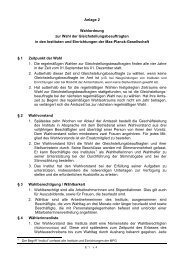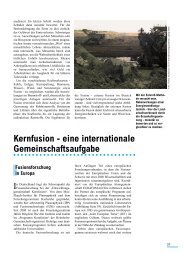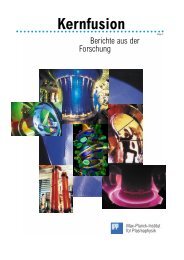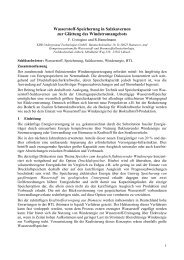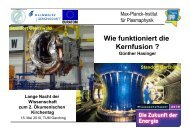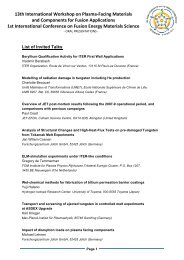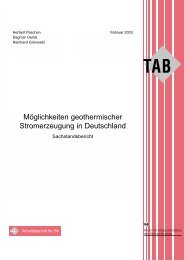IPP Annual Report 2007 - Max-Planck-Institut für Plasmaphysik ...
IPP Annual Report 2007 - Max-Planck-Institut für Plasmaphysik ...
IPP Annual Report 2007 - Max-Planck-Institut für Plasmaphysik ...
Create successful ePaper yourself
Turn your PDF publications into a flip-book with our unique Google optimized e-Paper software.
eing created quite detailed in one piece with contact interfaces<br />
only at places where such ones are also in reality. The<br />
ADINA GM is expected to be the most accurate and fastest.<br />
However, the modelling is not finally finished, the central<br />
support structure including the interfaces to the coil still<br />
have to be completed before an extended test and benchmarking<br />
phase can start. The model is now expected to be<br />
fully operational in the second half of 2008. The ANSYS GM<br />
as the main FE-tool was created in the last years with first<br />
priority with the help of the Efremov <strong>Institut</strong>e. The development<br />
activities, i.e. continuous updating and improvement<br />
of the model, are still ongoing at <strong>IPP</strong>; however, the contract<br />
with Efremov <strong>Institut</strong>e was closed. Both versions of this GM,<br />
the half module model with boundary conditions representing<br />
the stellarator symmetry (so-called 36° model) as well as<br />
the full module model (so-called 72° model including also<br />
the cryolegs) with cyclic boundary conditions are the workhorses<br />
which are heavily used for all kind of magnet system<br />
analyses. The 72-degree model is applied for analysing<br />
effects which are not in accordance with the stellarator symmetry<br />
like the presence of cryolegs and the dead weight.<br />
However, the module model requires enormous resources.<br />
One run takes typically one week for full load history which<br />
includes bolt preload, dead weight, cool-down, EM force<br />
application, and optionally the effect of winding pack (WP)<br />
embedding. The presence of the cryolegs and the deadweight<br />
result in 5-20 % asymmetry in the displacements<br />
and support forces between neighbouring 36-degree semimodules.<br />
In addition, the rigid body toroidal movement of<br />
the Magnet system is induced by the central structure deformation<br />
and corresponding tilting of the cryolegs. The<br />
ABAQUS GM emerged from a simplified model used for<br />
predicting magnet system deformations during different<br />
assembly steps – the results had to be considered for assembly<br />
procedures and tools. Starting from this basic model it took<br />
relatively small effort by LTC comp. to create a 36° version<br />
of GM in 2006 and a 72° version until the end of <strong>2007</strong>. The<br />
model is now installed at the <strong>IPP</strong> Greifswald and first structure<br />
analysis confirmation runs have been started. The model<br />
benchmarking with ANSYS GM shows good agreement<br />
of the main results. Minor discrepancies are still under<br />
checking and verifications in both GMs. ABAQUS will also<br />
be used for special tasks for which this program is better<br />
suited (e.g. for strength limit analyses which requires elastoplastic<br />
material properties and option of large deformations).The<br />
main GM applications are calculation of main<br />
stresses, deformations and forces/moments in the main<br />
structural elements occurring during different modes of<br />
operation such as bolt tightening already at room temperature,<br />
applying dead weight, cooling to cryogenic temperatures,<br />
and applying the electromagnetic forces. Also the<br />
influences of the winding pack embedding pre-stresses,<br />
different friction factors at the gliding elements, tolerance<br />
Wendelstein 7-X<br />
39<br />
deviations, NSE and PSE gap variations, etc., can be simulated.<br />
The GM is also used for prediction of handling deformations<br />
during assembly. A further application of the GM<br />
was the definition of positions for the mechanical instrumentation<br />
of the structure.<br />
Figure 13: Over-spreading of non-planar coils to install oversized lateral<br />
support block for weld shrink compensation; deformation in mm.<br />
The original study of the Magnet system behaviour and optimization<br />
of the parameters was performed for four main<br />
plasma scenarios with maximum current in different coils,<br />
corresponding to an on-axis field of 3 T. Preliminary analysis<br />
of the remaining 5 operational scenarios reveals that due to the<br />
high nonlinearity of the system some of the supports might<br />
be loaded to the limits already at plasma axis fields somewhat<br />
below the maximal design value of 3 T, therefore the<br />
operation limits in particular for these additional scenarios






